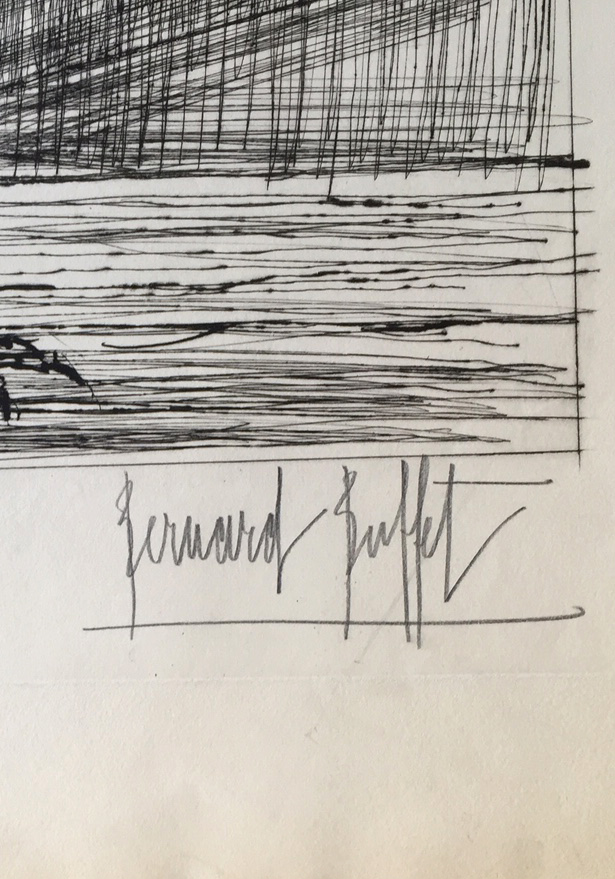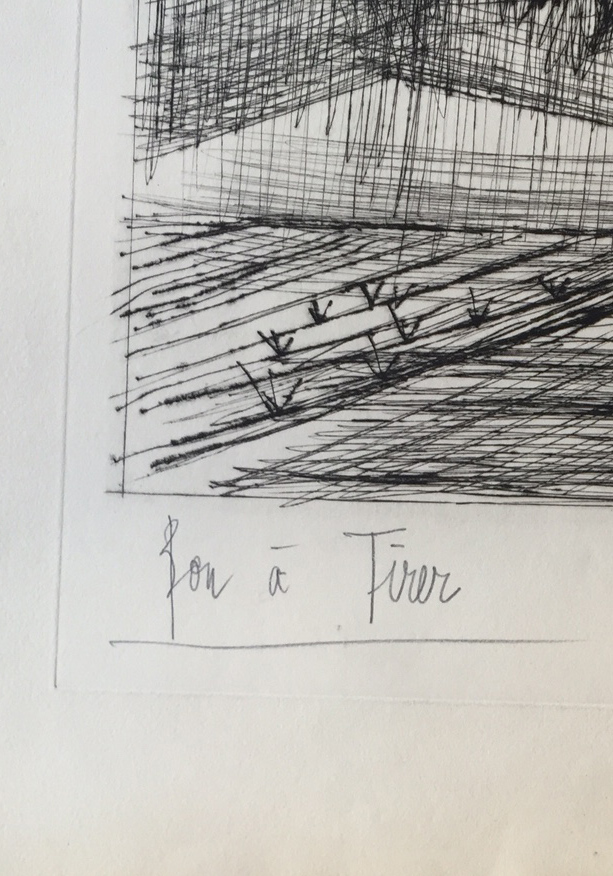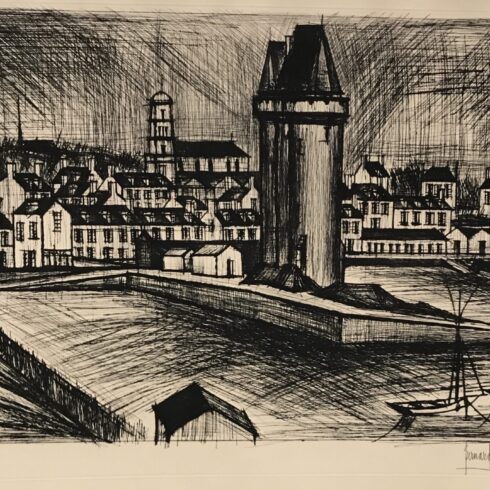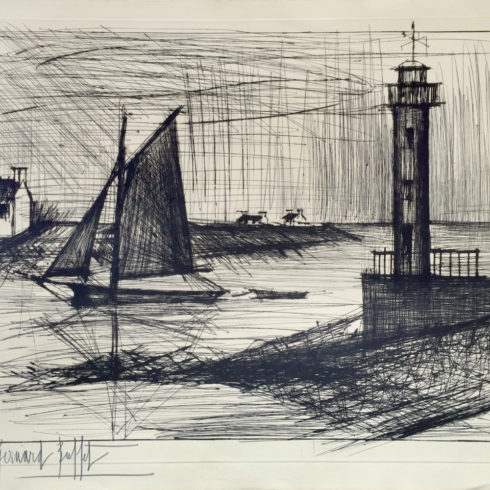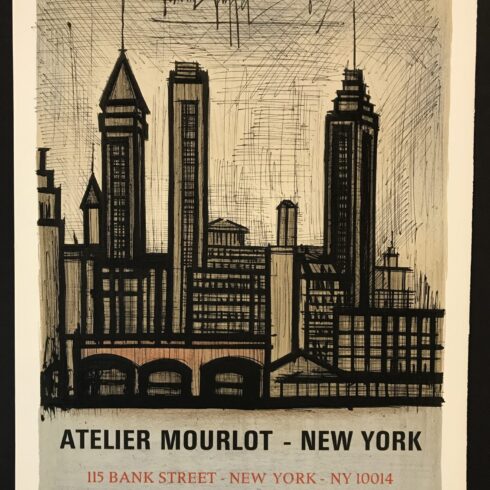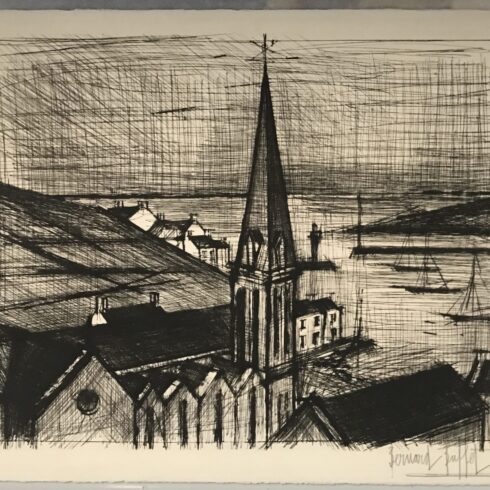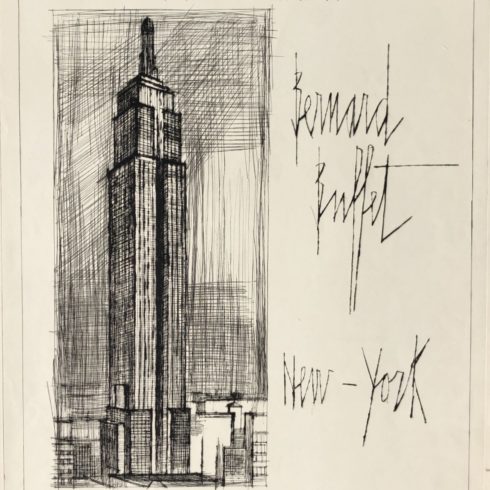Bernard Buffet – Le Coq
Bernard Buffet, Le Coq is an original drypoint engraving. This print is signed on the bottom right margin and annotated “Bon a Tirer” on the lower left margin. Printed by Atelier Lacouriere et Frelaut. Rheims 22.
The Bon a Tirer, which translates as “Good to Print” is the final proof before the regular edition is printed. Annotated “B.A.T.” this print can sometimes have notes from the artist to the printers, and can be a window into the artistic process of printmaking.
The style of Bernard Buffet is defined by “dry” straight lines revealing the shape of buildings and bodies. His works show elongated, emaciated figures and structures and lend a feeling of despair and loneliness.
While Le Coq is not necessarily considered “pretty”, the desire for a modern ideal created the need for his stark and somber images expressing intense emotion Buffet’s style focused on older, more conservative statues of art, such as drawing, while playing on the continuous popularity of Existentialism. Buffet’s figures are long, desolate, and solitary, yet at the same time empathetic; and they resonate with the public and critics alike.
| Title | Le Coq |
|---|---|
| Alt. Title | The Rooster |
| Medium | Engraving |
| Year | 1959 |
| Edition | BAT |
| Catalogue Raisonné | Rheims 22 |
| Signature | Signed |
| Size | 29.75 x 22 (in) 75.5 x 56 (cm) |
| Price | SOLD |
Description
Bernard Buffet, Le Coq is an original drypoint engraving. This print is signed on the bottom right margin and annotated “Bon a Tirer” on the lower left margin. Printed by Atelier Lacouriere et Frelaut. Rheims 22.
The Bon a Tirer, which translates as “Good to Print” is the final proof before the regular edition is printed. Annotated “B.A.T.” this print can sometimes have notes from the artist to the printers, and can be a window into the artistic process of printmaking.
The style of Bernard Buffet is defined by “dry” straight lines revealing the shape of buildings and bodies. His works show elongated, emaciated figures and structures and lend a feeling of despair and loneliness.
While Le Coq is not necessarily considered “pretty”, the desire for a modern ideal created the need for his stark and somber images expressing intense emotion Buffet’s style focused on older, more conservative statues of art, such as drawing, while playing on the continuous popularity of Existentialism. Buffet’s figures are long, desolate, and solitary, yet at the same time empathetic; and they resonate with the public and critics alike.
Buffet was born in Paris in 1928 and grew up during the Nazi occupation, enduring the war and years of deprivation, and the experience inspired much of the glum imagery in his work. He excelled in painting and drawing, winning prestigious prizes and attracting attention with a signature style recognizable by thick, angular black lines that outlined his somber themes.
Embodying Jean-Paul Sartre’s Existentialism and Albert Camus’s Absurdism, Bernard Buffet’s painting conveyed the anxiety that permeated France during the Nazi occupation and came to dominate the post-war figurative art scene. A member of a group called L’Homme Témoin (The Witness) along with Bernard Lorjout and André Minaux, Buffet developed a realist style infused with social criticism, featuring a restrained palette and black outlines. He is best known for his grim “Horror of War” series and myriad streetscapes and interior scenes populated by angular, emotionless figures. Self-portraits, religious scenes, still lifes also figure among his oeuvre, which extends to lithography, engraving, and sculpture. While Buffet continued to enjoy success as a commercial artist until a debilitating illness prompted him to commit suicide, his work fell out of favor among critics in the 1960s and remains relatively unknown.
Additional information
| Title | Le Coq |
|---|---|
| Alt. Title | The Rooster |
| Medium | Engraving |
| Year | 1959 |
| Edition | BAT |
| Catalogue Raisonné | Rheims 22 |
| Signature | Signed |
| Size | 29.75 x 22 (in) 75.5 x 56 (cm) |
| Price | SOLD |



